Tuesday, October 24, 2006
Alive in the basement
I'll cut to the most relevant stuff. We made it to New York on October 9, almost exactly a month after we left Paradise. We're staying in the basement of the house where my friend D. and his parents live. Thanks to their remarkable generosity, we've had a pretty good time of things so far. We've been taking the train into the city to search for apartments and jobs. We have leads on both, though I won't say more until something concrete happens.
New York is picturesque both in and out of the city. D. and his family live in Croton on Hudson, a village 42 miles north of NYC and just a few miles away from Sleepy Hollow, Washington Irving's old stomping grounds. After the mega expressways we traversed across Pennsylvania and New Jersey, the kind of tight, forested highways in this part of the state were like driving on another planet--and almost getting run off the road by the aliens when the lane width suddenly constricted.
There's a lot more to say, but I haven't organized my thoughts. The last two weeks have been a haze of craigslist advertisements, hour-long train trips and staying up until 4 a.m. for no reason. It's finally getting cold, and the red, orange and yellow leaves scrape across the roadway the way I remember from the 1989 Tim Burton version of Batman. On one hand it feels like our journey has ended. We've been stationary for two weeks. But on the other, we're not in the city yet. I know there's another chapter or two here before I can say "I live in New York," but I can't say for sure if they have begun yet.
I will say that the city is a lot cleaner than I expected, and the public transportation is excellent. The subway cars are well kept and the trains run all the time. Also, it's almost like Disneyland when you step off the 4 Train and there' s a full steel-drum band playing on the opposite platform to a throng of mesmerized commuters. I will have more to say. We have met people. I have had some excellent conversations with D. and his parents. But I should sleep now. Later today my electric guitar will come in the mail--and maybe I'll have Rolling Stones tickets.
Saturday, October 07, 2006
On tourism, patriotism and other cliches
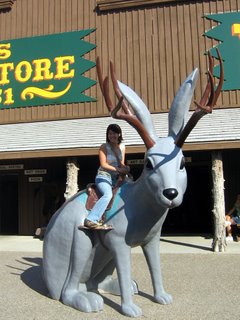
October 1:
Lost in Middle America
I am in South Dakota. That right there is enough to give me pause. It’s time to start evaluating your life when you stop for a moment and realize you’re in South Dakota. How did I get here? Do I know where I’m going? Because if I don’t, there’s an equal measure of wilderness and desolation in every direction—empty streets patrolled by hungry deer.
We’re in South Dakota for two reasons, really. First of all, we came to see Mount Rushmore. Second, I-90 runs through it, and this is the road that will take us to New York. A happy coincidence that places us here in the Black Hills, right?
Except I look around and I get a strangely desolate feeling. I know I’m nowhere close to my destination, and yet I’ve been on the road for nearly a month. Through an exertion of funds and rudimentary navigational skills, I’ve come more than a thousand miles. All our West Coast friends are behind us now. There will be no more welcoming homes until we hit the Empire State. And so the daunting expanse of Middle America stretches in front of us, a queue of motor lodges at midnight in shuttered hamlets barely respirating on the fumes of the interstate.
That is, when there ARE hamlets. We drove through Wyoming two days ago. After spending the whole day in Yellowstone National Park, we realized we had to book across the whole state in order to reach Rushmore in reasonable time the next day. What followed was a mad dash in the dark.
We set out for Yellowstone’s northeast entrance at about 6:30 p.m. We had used up nearly all our gas driving through the park (we were 39 miles from Old Faithful; the gate was another 46 miles in the opposite direction), so we planned on getting fuel at the gas station marked on the park map next to the gate. We passed a much closer gas station, not wanting to veer from the plan. This decision would come back to haunt us.
I drove up, up and up, pausing for herds of bison and elk. It was remarkable to see them so close, so indifferent to motor traffic. Just like the three or four other cars inevitably delayed by the grazers in the road, we whipped out the camera and shot pictures like crazy.
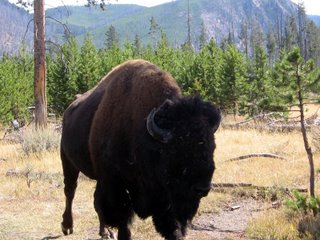
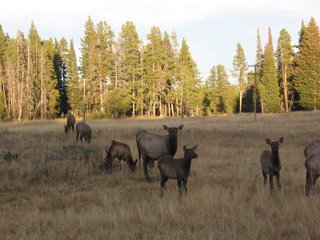
By the time we got to Roosevelt Lodge, the location of the gas station, we were thoroughly sick of the shaggy, four-legged poop machines. We were further dismayed to see the gas station closed down and covered up. It was 29 miles to the gate and we had maybe 8 miles until the point where we always refuel the car. I set off toward the gate with a newfound urgency, knowing a.) the fuel would probably last, but not enough to take it slow, b.) this gate closed at 8 p.m., and it was already 7:30, and c.) it gets very cold in Yellowstone at night.
I raced across the darkening plains, eyes scanning desperately for the bison I knew would be blocking the road. Time and time again we got stopped by the woolly bastards. As if on cue, those grazing on the shoulder would dart in front of Beaker.
It was completely dark when we shot out of Yellowstone on Highway 212, only to find the highway was a decaying, two-lane blacktop through dense forest. We finally got gas (only because the closed gas station had a credit card machine) and resolved to drive until we hit a city.
Little did I know how rare those are in Wyoming, which sets new standards for desolation and loneliness. It turns out the entire state has fewer people in it than the city of San Francisco, and 5.1 people per square mile. The national average is 79.6.
I drove for 15 minutes on Highway 16 before seeing another car. There were no streetlights. There were no towns of any size. There were no traces of civilization outside of the signs warning us about open range cattle taking the place of the bison in the middle of the road.
We drove into some valley and then up some anonymous mountainside, seeing maybe five cars in two hours. The road was tight and winding, with 20mph switchback after 20mph switchback and never so much as a glimpse of a house, a settlement or even the terrain. Literally we were the only light pollution within 20 miles.
Our destination was Cody, the largest dot on the map for hundreds of miles. We arrived at 10 p.m., hoping to see a burgeoning metropolis. Cody has 8,800 residents—one-third the size of Paradise. Still, there were streetlights and restaurants and people, so it was a bit of an oasis. In fact, downtown Cody is nicer than downtown Paradise, full of historical buildings, free parking and restaurants. But maybe a small town like Cody can afford such a downtown area because it’s the only place people can stop for a bite to eat in northwestern Wyoming.
We thought about staying the night in Cody but realized that we needed to make it to Gillette that night, another 200 miles through another national forest. Remembering the terrain at Yellowstone and the previous stretch of road, I was not enthused, but we had little choice. We had to get to I-90 again, on the other side of this forest.
Again we plodded on. The lights of Cody soon faded below the horizon and all was black again. At first, though, we passed through several towns. Wyomingites seem to like brightly lit, flashing signs. It’s odd to drive through a completely deserted town at midnight and see a glittering minature strip gaily splashing color across the street and shuttered buildings as if there were someone to see it.
We arrived in Sheridan at 1 a.m., finally on I-90 and free of the punishing uphill climb through the mountains. The roads had turned red for some reason, perhaps the sand the transportation department dumps on the roads during winter carries this ferrous color. It was eerie.
Val drove the last hundred miles to Gillette, singing along with the CD player to stay awake. We were nervous about getting a motel room so late. Would a clerk be on duty? Would their policy allow for a guest at 2:30 a.m.?
The answer was yes, and they even gave us a discount. Good thing, too: the Motel 6 cost us $73 due to the late hour and a AAA discount. You read that right. Seventy-three dollars. In the room we looked at the regular pricing rate. For two people, a single room ordinarily costs $139. At a goddamn Motel 6.
My guess is that motels are expensive because there are maybe 10 of them in the entire state of Wyoming. Spare rooms are a hot commodity when a traveler’s other option is to pull off the road somewhere and hope he doesn’t freeze to death, fall into a giant strip mining pit, get eaten by bears or hit by a semi.
By comparison, South Dakota is positively metropolitan, with actual billboards, lights and towns. And fireworks stands everywhere.
The region encompassing Mount Rushmore, Keystone and Rapid City is tourist central. The landscape, already beginning to mutate into the jagged, weathered spires of the Black Hills, is festooned with bright billboards crowing the virtues of assorted seedy roadside stops. Come see Bear Country USA, with more than 100 bears! Come to Reptile Gardens, the largest reptile park in the country! Plunge into Sitting Bull Crystal Caverns (resplendent with photo of bright-eyed, curly-haired teenager with unnatural smile nest to a stalactite).
Not being a parent, I don’t know if the marketing is plying parents to shut their kids up by foisting some seedy entertainment on them, or if it plies kids to whine and pester their parents until they pull off and pay $50 to a bored man in a bear suit to shut them up.
Keystone is a town that thrives on this kind of tourism. Since they’re only a couple miles from Mount Rushmore, the entire town is a snare for trinket- and sweet-loving road warriors.
As we drove through the wide streets of Keystone, gawking at the animated marquees of motels and souvenir shops, Val noticed something.
“Is it just me, or are people really fat around these places?” she said.
“It’s not just you. Tourist traps are a siren song to the obese. And what’s worse, they peddle fatty foods, so it’s a vicious cycle. Fat people love tourist traps, and tourist traps make people fat.”
She chuckled.
“If you’re here, the odds are you’re middle-aged, from Middle America—and your middle is immense,” I finished.
And since Mount Rushmore is inherently patriotic, it’s also a natural fit for the kind of horrifying national pride paraphernalia frequently seen draped over some obese woman’s pendulous breasts—all flags, eagles, ribbons and fighter jets in ingenious new formulas. Let’s envision one now together: a bald eagle in the cockpit of an F-16 Falcon, a “support our troops” ribbon painted on the fuselage, tears streaming down his face, the smoldering World Trade Center towers behind him, all against a background of the stars and stripes. “Never forget.”
Oh, I’ll never forget. You can depend on that. I’m going to see that shirt every night in my nightmares.
But then of course there are landmarks that conjure up the charm and strength of America without the schmaltz and flag-waving.
Wall Drug in Wall, S.D., is one of these. Though it’s obviously a tourist trap, it’s also richly decorated with Western art...
... and a thorough history of the family who founded it.
All through the immense store there are photographs and newspaper articles. It’s like walking through the family’s scrapbook. That in itself is appealiing. There are photos of young men in World War II, in front of airplanes and artillery; of family hunters over six decades; of explorers in China and Africa and under the sea. I find this a much stronger testament to America than the more blatantly patriotic monuments. Here was a man whose strong entrepreneurial sense helped a drug store to survive and flourish in a small, remote town for more than 70 years. For his efforts he met congressmen, senators, presidents and astronauts. For sale in his gift shop we find more tractors and toy muskets than eagles and flags and such. All American dream, little of the fanfare. The fact that Hustead’s simple vision endures is inspirational.
Accepting the obviousI am a tourist. It’s hard to admit that sometimes, hard to lump myself in with that band of jackasses tooling around the country in $160,000 motorhomes. But I’m out here trying to find the sights, just like everyone else. I can put on airs of superiority or self-awareness, but we drove to South Dakota so we could gawk at the four giant granite heads of dead presidents dynamite-blasted into a mountain, just like everyone in the flag T-shirts.
Of course, with a little careful trick photography, we could have just photographed ourselves with this incredibly picturesque soft drink vending machine in the parking garage and convinced everyone that we had braved heart failure, perspiration and diabetic coma to climb the stairs to the viewing platform itself.
Mount Rushmore is sublimely unsubtle, a gross, somewhat destructive symbol of our country. It was designed and its construction was overseen by a stubborn and fanatical sculptor who dreamed of not just the presidents' heads, but their whole torsos--and a hall of records underneath containing the founding documents of the United States (good luck getting the Smithsonian to agree to that, Gutzon). The project was completed in fits and starts and ran out of money when World War II began.
With just as much subtlety as the giant dead men's faces blasted into the rock, the monument has a promenade festooned with state flags and a constant barrage of patriotic muzak (and Avery Brooks doing a chimes-laden voice-over history of the monument). Though I don't like to play the tourist, it’s big and loud enough to get my attention. I can’t beg out of that one.
For those of you horrified by the sudden appearance of giant dead white men on mountain faces in sacred Native American territory, the Crazy Horse Memorial may either salve the hurt or amplify it.
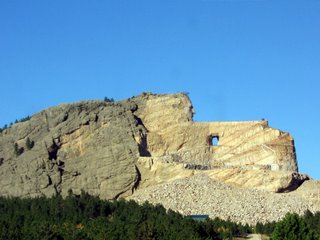
Undertaken in 1948 by a sculptor even more fanatical and dedicated than Borglum, this monument is being constructed without any government funding, because its creator believed Americans' tax dollars shouldn't be used. Rather, he said, the people who wanted it would come forward to subsidize it. Nobody knows when it will be finished.
The monument was conceived as a response to the white-centric history embodied in Rushmore and is part of an incredibly ambitious plan for the land, which includes a Native American medical university. If you feel like paying the $20 to visit the museum (bus rides up to the mountain are an additional $4), there's a very informative video to watch.
I am a tourist, but then again, I'm not. Drawing distinctions between me and the fat dude with no chin and a peachfuzz beard staring just as intently at Lincoln’s face to see his mole—that becomes increasingly important as I spend more time out here, as I laugh and half-consider visiting the roadside attractions, as I ponder buying souvenis, as I eat greasy burger after greasy burger at places claiming to be world famous for something or other.
I am different, though. I am moving across the country, not headed back to the suburbs.
In some ways I’m the same. The more I see, the more pride I have in the American landscape. We’ve got amazing, jaw-droppingly dramatic terrain loaded heavy with the history of restless men and women trying to traverse it, tame it or transform it. The energy and ambition the people of this nation have collectively sunk into the land is remarkable.
We wanted to eat at Olive Garden for lunch today, since we’re burned out on burgers. We both felt a little bad for gravitating toward a franchise restaurant, but it was there and we didn’t have time to scrounge around in Rapid City for three hours in search of a local place.
It was 1 p.m., the end of the lunch hour, so we expected it to be fairly quiet.
Not so. The place was packed to the gills with locals (or at least South Dakotans, judging from their license plates). A dozen people were sitting in twos and threes outside, patiently reading menus. Inside every single bench was fillled. It was 20 to 30 minutes for a party of two.
Come on, South Dakota. Leave the cheesy yuppie franchises to weary interstate travelers!
***
October 2:
How does one write these things?
Now we’re in Wisconsin, having spent all day driving through Minnesota. It seems the air got muggy the moment we passed the state line.
We did not go to the SPAM museum. We dedicated the day to driving and I didn’t want to stray from the plan. I still felt a pang of regret. We passed up a free roadside attraction. There are times when I think that because we’re writing about a transcontinental voyage, we’re compelled to visit as many tourist traps as possible. I don’t know where this idea comes from. We never promised to do this before we left, and I have no idea if anybody’s reading this besides a couple of close friends and our parents, but I have the urge to entertain, to plumb the banal depths of our fair land for the sake of a good read.
But what would this really accomplish? I suspect that after the fourth or fifth day of forking over $20 to see the dessacated corpse of some abnormally large native animal, I’d wind up feeling both swindled and concerned that the true audience for hoplessly tastless roadside attractions is cynical, self-aware young people. And what would we get if we did stop everywhere? Some kind of kitsch trophy made from angel figurines and 8-tracks?
I’m drawing the line, so for the next few days, I’ll be talking about endless stretches of straight raod, yellowing treelines and dumbasses in minivans.
I get self-conscious just writing about the scenery. America’s beauty is an immense cliché perpetrated by travel agents, elementary school posters and PBS nature specials. Cliché as it is, it’s still beautiful. There’s so much open space, still so much meditative expanse devoid of housing tracts and Applebee’s restaurants, that you almost forget that these suburban things are rapdily assuming our national identity.
It’s all much better to look at from the window of a car at 70 mph than it is to stop and witness, however. I see corn fields and three things instantly run through my head: a romantic longing for a mythical, noble agrarian past; the kind of magical autumn sparks I remember from “A Charlie Brown Halloween” and corn mazes; and that scene with the crop duster from “North by Northwest.”
But behind the pretty views are people whose political views I don’t share, whose music I can’t stand, and who would probably look on me with scorn because I don’t know how to castrate a bull calf.
We’re dashing toward Illinois now, following the lead of our friend C., who is en route to a new job in Florida and who got through Idaho, Montana, Wyoming, South Dakota, Minnesota and Wisconsin in a single day. He left at 6 a.m., though, while our routine gets us up and running at a leisurely 11 or noon. We’re trying to change this, but I always get to the motel room strangely enamored with the idea of a bed and a TV and a luxurious span of stationary time. We watch movies and TV, write, and generally disregard the fact that we will be sleeping until near check-out time.
Friday, October 06, 2006
Alone on the road in Big Sky Country
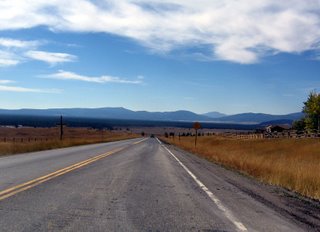
September 29:
We’re driving through central Montana now, en route to Yellowstone. The phrase “purple mountains’ majesty” keeps running through my head. I assume these are the Rockies in front of me right now as we head south on Highway 191. They’re beautiful—and mysterious.
“I like looking at mountain ranges that are unfamiliar,” Val said. So do I. It’s reassuring that the world is still this rugged and immense in some places; that I have not known all the mountains there are to know.
This is definitely wilder country than I’m used to. About half the big rigs that roar past are equipped with steel bars over their headlights and grilles: protection against the damage a wayward elk or deer can do at 60 mph.
But while it’s rural and austere out here, the people in this area have incorporated modern amenities. Farmers use electronic tags and GPS to monitor cattle. Grain silos are mouse-eared with satellite dishes.
I know it’s not written in stone anywhere that people in rural America have to live in primitive conditions, but still the presence of some of this technology is strange to me. This place with its vast prairies, bare hills and distant, snowy mountains reminds me as much of the frontier as just about anywhere I’ve been, and yet I can find wireless internet in just about any roadside motel.
While you can definitely get the amenities when you stop for the night, the trek can still be daunting. There are no streetlights along I-90 in Montana, only the taillights of the semis and the awareness of the unfettered landscape slumbering in the blackness. For this reason, I think the state focuses on communicating more frequently with the motorist. The green signs indicating the distance to the next few towns come more often than they do in California. Where you mark your progress to Redding or Los Angeles in 11-mile increments on I-5, in Montana these signs give you updates every three miles.
“No, you can’t see anything in any direction, no you don’t recognize the names of such places as Tarkio (indie music dorks may recognize the name from Colin Meloy's pre-Decemberists band) or Alberton, but you’re not lost. You’re making progress.”
Also, to combat the encroaching remoteness, everything here is world famous. Roadside bars, general stores, restaurants—put your mind at ease, lonesome traveler. YOU ARE CLOSE TO SOMETHING SOMEONE OUTSIDE OF THE STATE HAS HEARD OF BEFORE.
I love the views out here, but I can’t get in sync with the music. We ate at an Arby’s in Butte last night (no three pepper hot sauce here, dammit) and had to listen to a steaming heap of contemporary country.
“Cadillac Tears”? I tried to appreciate the dark humor in a revenge story involving perpetually buying Cadillacs with the alimony from a divorce, but what the song is trying to cast as poetic-justice female empowerment just comes off as a self-perpetuating cycle of victimhood.
Hey man, she’s cruisin’ down the street with custom wheels and leather seats
You know, she gets a new one every year
Aw, she’s crying big Cadillac tears
How many years does this woman have to dwell on the failed marriage and the man who hurt her? Isn't this celebrating the self-perpetuation of a culture of victimhood?
We talked about modern country music last night on the way from Butte to Bozeman. The myth of authenticity pervades most forms of popular music, but it’s especially potent in country, where current artists and songwriters continue to peddle a hoary false dichotomy: country versus city; dirty pickup versus BMW; poor versus rich; simple versus sophisticated; authentic versus phony.
Nashville is a big city filled with talented songwriters and musicians. It’s a pillar of country music. The people recording this music aren’t playing out on the back porch with pawn shop-bought Stella guitars. They’re playing brand-new Fenders and Gibsons in state-of-the-art studios with professional musicians. It’s sophisticated, and that’s OK. Slickness has long been a part of country (Nashville didn't just spring up in the 1980s as a songwriting and recording mecca). We don’t have to write artless lyrics and dial up the twang to compensate for the fact that we make slick music. Lyrics can be more artful than “she thinks my tractor’s sexy.”
I can’t stand the saccharine sentimentality in some songs; the disregard of cadence in others (when I hear Gretchen Wilson sing “keepin’ it counTRY,” I want her to drown in a mudhole).
But I’m moving to New York, so what’s the point of opining about this? I won’t be a ranch hand or truck driver anytime soon.
Still, it bothers me how these artists often sing about leering caricatures of their listeners—and how the listeners eat it up and cheer for more.
Flashback fragment (sorry, no pics)
September 13:
I’m writing from a motel in Medford, Oregon, after spending two days in Eureka. Well, two nights and one day in Eureka.
We finally left Paradise on Monday, Sept. 11. Packing the car for the trip was both easier and more difficult than we thought. It took the whole day Sunday, yes, but we wound up with a sliver of rear window visible in the mirror—a lot more than I expected. It was dark when we finished packing, though, so we slept the night at home before leaving.
As we were driving out of Paradise Monday afternoon, Val said, “This is the last time for a long time we’ll be driving down the Skyway.” I realized it was true as I looked out the window at the excavators making a mess of the formerly wooded stretch of land west of Neal Road. I’m wondering how long it will take the quilting stores that invariably set up shop in these places to go belly up.
***
We drove to Redding and took Highway 299 to Arcata. This was the same road we tried to drive at the end of July for a camping trip. That time we were turned back at Weaverville by an immense wildfire, forced to divert to the intestine-like (and intestinal) nightmare that is Highway 36.
This time the road was open and we passed through without incident, though smoke hung heavy in the air and the still-high sun was a dull red disc. Highway 299 curves through a river canyon, and as we rounded one downhill curve toward the bottom, we were confronted with a face of sheer, jagged rock blackened by the blaze. We had plenty of time to admire its dissonant majesty as we followed the Forest Service fire truck down. At the bottom of the canyon we found all the fire camps, dwelling places for the firefighters who extinguished the wildfire. There was still plenty of activity, many tent villages and trucks. It reminded me of the week I spent during one childhood summer at a fire camp when my father was working as a dispatcher. The details are hazy, but I remember there was a “Creek” in the name of the settlement (Brush Creek, maybe?), and I remember staying at a pleasant house belonging to a local family. I can remember sitting on a swing in the backyard near the dense treeline, eating Reese’s Pieces for perhaps the first time in my life.
So much time has passed since I was sitting on that swing. I remember hanging out at the camp during lunch, watching the grimy firefighters come in for their picnic sandwiches and sodas, thinking, I can be one of them someday. Back then I think part of me felt a career with the Forest Service was inevitable. I had a blood tie to these environments. At some point, though, I turned nerd.
Driving down the road Monday, watching the rows of dome tents whiz past my window, I thought about being a firefighter: where you have to train for it, how you get hired, and what the age limit is. I thought about my chances of ever doing what I had anticipated as a child. I don’t think they’re spectacularly good.
I could still do it, I’m sure. I’m smart enough to learn, and my body is intact (if untrained). But I’d have to crave it enough to focus, and that’s hard. I just read The Orchid Thief, by Susan Orlean, which is a book just as much about wanting to feel passionately about something as it is about pretty flowers. I recognize Orlean’s longing, and kindle a small fear of forever being a dilettante.
But while I think about the satisfaction that might come from mastering a certain field and satisfying the child who dreamed about donning the yellow Nomex suit someday, I also think about sacrificing my potential to do other things.
It’s an ironic stasis I’ve created around myself. I’m too scared of wasting my life on any one thing to actually do anything, so by default I’m wasting my life.
We finally got to Eureka after 8 p.m. Val said her friend recommended a Chinese restaurant along Highway 101, just as we drove past the parking lot. Though I had only been driving for five hours (and certainly would drive more in coming days), I felt fatigued and afraid of a long, fruitless search for an appealing-looking restaurant. I turned the car around—a left turn and then another left onto the divided northbound lanes of 101—and headed back, only to find there were no left turns for miles. Silently we drove toward Arcata, waiting for any kind of opportunity.
Ten minutes later, we were at the restaurant. It was cold outside. I was tired, keenly aware of the fact that my most important worldly belongings were packed in a compact car in a strange town. We walked in, sat down, and ordered some very disappointing Chinese food. Mongolian beef is supposed to be spicy. And completely cooked.
Tuesday, October 03, 2006
National parks and dynamite sculptors: We are tourists
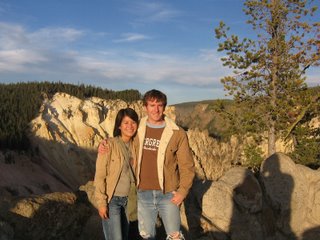
It's late at night and I've got four pages of assorted travel musings saved on the little portable word processor we keep in the car, but I'm too lazy to run down there, get it, and figure out how to transfer it to the laptop, so those things will have to wait, just like my post about kayaking Puget Sound with W. and A.
Now for a quick update. It's October 3, and we're in Rockford, Illinois. We drove through Minnesota and Wisconsin today, weathering the most vicious thunderstorm I have ever seen. We crashed here and watched TV all night, savoring the feeling of being dry and not cooped in the interior of a Honda Civic carrying all our worldly belongings.
We have seen Yellowstone National Park, Mount Rushmore, the Crazy Horse Monument and Badlands National Park. We will write about these things--or transfer all the word-processed files--shortly. For now, here are some teaser images of Yellowstone.
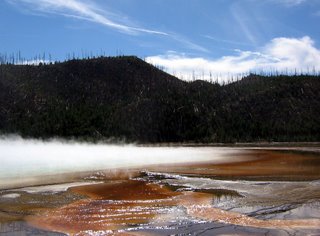
The bacterial plate at one of the park's many thermal pools.
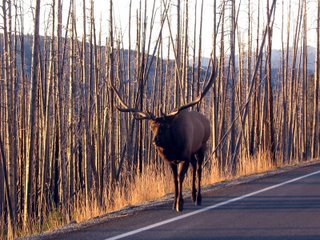
Big bull elk doesn't realize pedestrians are supposed to walk on the LEFT side of the road.

Bison! These woolly bastards were everywhere we wanted to be. Like the middle of the road out of the park at nightfall.

Old Faithful. We waited a very serene 25 minutes with about a hundred other people for the eruption. It was impressive.
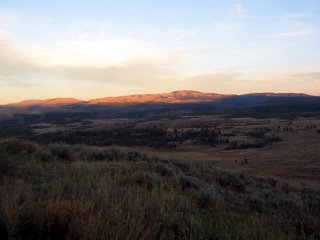
The view as we left the park. Behold the full justification behind all the cliches of America's scenic splendor.
 Beaker Chronicles
Beaker Chronicles



